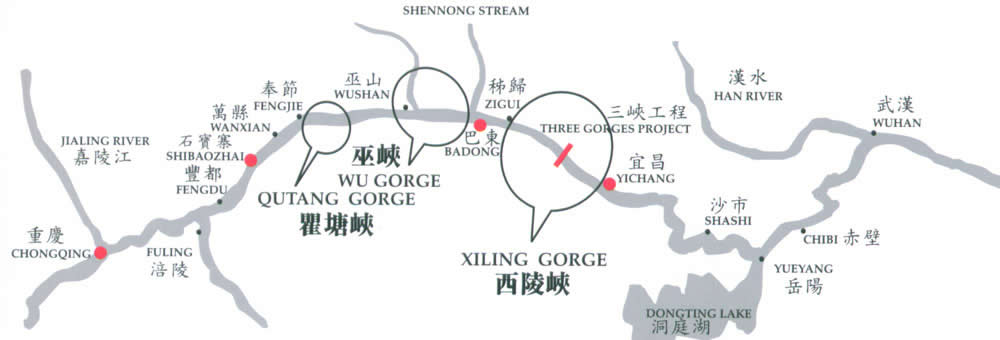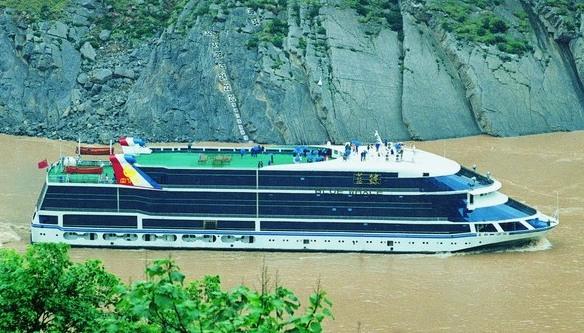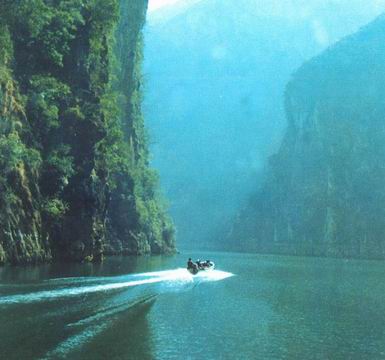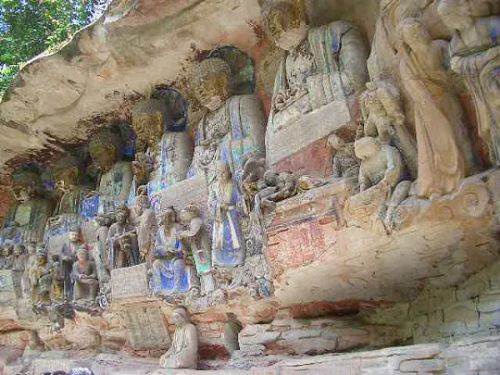『Chongqing and the Three Gorges』

Abrreviated
as “Yu”, Chongqing is located in the center of Northwestern China where
the Yangtze river and Jialing river meet. It became the fourth
municipality directly under the central government in 1997. With an area
of more than 82,300 square kilometers, Chongqing has a total population
of 30 million, including Hans, Huis, Miaos, Tujias and other ethnic
peoples.
Situated in the eastern part of Sichuan basin, Chongqing is
screened
by mountains in three sides of north, east and south, hence the
nickname, “ The Mountain City”. The Yangtze river cross the province
from southwest to northeast, and cuts through mountains. Here the river
course suddenly narrows and the waters become turbulent. Sheer cliffs
and steep mountains rise on either side, creating one of nature’s most
fantastic sights --- the three gorges. Situated in the subtropical zone
with a monsoon climate, Chongqing is hot and suffocating in summer, and
is called one of the three “heating stoves” on the Yangtze river.
Chongqing is also known as a “Fog City” due to the fact that it is wet
and foggy in winter and spring, and it has 100 to 150 foggy days
averagely in one year.
Chongqing enjoys a time-honored history.
it is one of the famous chinese cities endowed with historical and
cultural significance. During the spring and autumn and the warring
state periods, it belonged to the state of ba; It was in the territory
of Yuzhou in the Sui and Tang dynasties, and became the capital of the
state of daxia during the late Yuan dynasty. In 1927, Chongqing is
incorporated as a city. During the war of resistance against Japan, it
was the “provisional capital” of China under the Kuomintang’s rule.
Major attractions include Dazu rock carvings, one of the unesco’s world
heritage sites, Yangtze river’s three gorges, revolutionary memorial
hall of the red crag village, Bai’s mansion and Pipa (loquat) mountain.
The Three Gorges of the Yangtze River
The Three Gorges of the Yangtze River, a well-known tourist attraction, start at Baidicheng in Fengjie County in the west and end at Nanjingguan Pass in Yingchang to the east, passing through Badong, Zigui counties and Yichang City in Hubei Province. The total length is about 193 kilometers. Apart from the Daning River Valley and the Xiangxi Valley, the three gorges themselves are 93 kilometers long. The first gorge of the three from west to east, known as Qutang Gorge, is 7 kilometers. Wuxia Gorge, the second one, runs from west to east for 44 kilometers. Xiling Gorge, the last one of the three, covers a distance of 42 kilometers.
The steep
mountains, the dangerous rugged shoals and the turbulent waters are
characteristic of the gorges. The almost vertical cliffs and grotesque
peaks with clouds wrapping them in a blanket of mist create one of
nature’s most majestic sights.
The area of the gorges was
also one of the cradles of Chinese culture of in ancient time. Here two
famous characters were born in Chinese history; Qu Yuan (340 –278BC), a
great patriotic poet and statesman of the third century BC and Wang
Zhaojun in the Western Han Dynasty (206BC –23AD), who did her bit for
the promotion of the national unity, as well as a host of great poets in
history, such as Li Bai (701 –762), Du Fu (712 –770), Bai Juyi (772
–846), Lu you (1125 –1210) and Su Shi (1037 –1101). All of them greatly
admired the beautiful and charming landscape and wrote down quite a
number of poems.
Actually, the gorges themselves are a long
poem, a mysterious natural gallery. Qutang Gorge is famous for its
magnificent precipices, which form a colossal, nearly perfect gate to
curb the river. Wuxia Gorge, with soaring mountain peaks rising stately
from the riverbanks, is severe and secluded and presents a panorama of
lovely scenery. Xiling Gorge is noted for its numerous hidden rocks and
perilous shoals. The picturesque scenery along the river, which never
fails to appeal to visitors, will surely make visitors admire the
mysterious creative power of nature.
Sailing down the Yangtze
River from Chongqing to Yichang, Hubei province allows visitors to see
the spectacular scenery of the Three Gorges along with its splendid
cultural heritage and fabled local folklore. The cruise, which combines
sightseeing with scientific, artistic and folklore exploration, is a
national-caliber tourist program. The 193-km-long Three Gorges is one of
the world’s major canyons. Along the way there are such major scenic
attractions: the Fengdu Mountain, Zhang Fei’s Temple, Qu Yuan’s Temple
and the Three Gorges Dam.

Daning River Excursion: The Three Little Gorges
The Daning River is the largest Yangtze tributary, which rises in the southern side of the Daba Mountain and flows for 250 km before emptying itself into the Yangtze at the western entrance to the Wuxia Gorge. The Lesser Three Gorges on the Daning River, a 50-km-long affair covering the Longmenxia, Bawuxia and Dicuixia Gorges in the lower reaches of the river, is billed as one of China’s 40 best scenic resorts thank so to its gorgeous mountains, elegant peaks, turbulent rapids, limpid water, exotic rock imagery and serene scenery

Dazu Rock Carvings
Dazu
Rock Carvings, located 163 kilometers away from Chongqing Municipality,
is one of five major grottoes in China. The carvings stared in 892 and
completed by the end of the Southern Song Dynasty (1127 –1278) lasting
more than 250 years. They are the excellent works of rock carvings
produced during the later period of grotto arts in China.In Dazu County,
more than 50,000 pieces of carved rock figures are scattered 75 major
sites in an area of 1,390 square kilometers. Those carved out of the
rocks at Beishan (North
Hill), the Baodingshan (Precious Peak Hill) and Nanshan (South Hill)
are most concentrated in number, the largest in scale, the finest in
craftsmanship and the richest in contents.
Dazu Rock Carvings, mainly consisting-of Buddhist images, are the commented as the “Oriental Carved Bible”. However, there are also separate areas of Confucian and Taoist images, and caves in which the founders of Confucianism, Buddhism and Taoism are placed together. Besides, there are statures of a commemorative nature of historical personages. What makes Dazu rock carvings unique is the large amount of statues, the refined carving techniques, the diversified subjects, the rich content and the excellent conservation. On June 22,2000, the World Heritage Committee of UNESCO presented Dazu the title of “World Heritage Site”.
